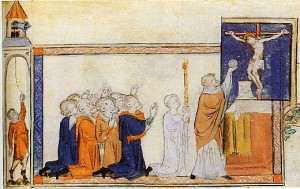 One of the fun things about studying worship and liturgy is finding out the origin of things we do, either consciously or unconsciously. One of my pet peeves is all the well-intentioned Sunday school teachers who exhort their students to “close your eyes and fold your hands” in prayer. Where does the Bible command this? Where do we see this bodily position used in Biblical prayer? We don’t, as far as I know. Imagine my delight when I came across a passage, from Miri Rubin’s Corpus Christi: The Eucharist in Late Medieval Culture, which explains the origin of this wide-spread custom. In the late medieval period, it was commonly thought that great blessings and spiritual merit came from seeing, and viewing, the bread of the Eucharist. The most powerful and effective viewing time was when the priest lifted up (elevated) the Eucharist. We have records of people running from church to church to see as many elevated Eucharists as they could. Since this was a holy moment, the people were encouraged to respond appropriately:
One of the fun things about studying worship and liturgy is finding out the origin of things we do, either consciously or unconsciously. One of my pet peeves is all the well-intentioned Sunday school teachers who exhort their students to “close your eyes and fold your hands” in prayer. Where does the Bible command this? Where do we see this bodily position used in Biblical prayer? We don’t, as far as I know. Imagine my delight when I came across a passage, from Miri Rubin’s Corpus Christi: The Eucharist in Late Medieval Culture, which explains the origin of this wide-spread custom. In the late medieval period, it was commonly thought that great blessings and spiritual merit came from seeing, and viewing, the bread of the Eucharist. The most powerful and effective viewing time was when the priest lifted up (elevated) the Eucharist. We have records of people running from church to church to see as many elevated Eucharists as they could. Since this was a holy moment, the people were encouraged to respond appropriately:
 “Proper humility was recommended at this moment, when people were to kneel and gaze at the body and the blood. This is the attitude most commonly shown in visual representations of the elevation, a group of men and women with clasped hands, and sometimes holding their hands to their mouths in a gesture of awe, kneeling behind the servers and priest. They are most frequently shown to be clasping their hands in a gesture which becomes increasingly common in thirteenth-century representations, one which we nowadays think of as natural for private prayer” (Corpus Christi, 155-56).
“Proper humility was recommended at this moment, when people were to kneel and gaze at the body and the blood. This is the attitude most commonly shown in visual representations of the elevation, a group of men and women with clasped hands, and sometimes holding their hands to their mouths in a gesture of awe, kneeling behind the servers and priest. They are most frequently shown to be clasping their hands in a gesture which becomes increasingly common in thirteenth-century representations, one which we nowadays think of as natural for private prayer” (Corpus Christi, 155-56).
 I don’t mean to be too hard on the Sunday School teachers, but it is simply interesting how we inherit all sorts of traditions from the past, and are blissfully ignorant of the origins of most things. This should make us both more humble in our own worship practices, as well as thankful for all the rich history and traditions that have been handed down to us. Thankfully, God sees the heart, which is really the point of prayer. May we all have hearts full of child-like faith, no matter how we express that with our bodies!
I don’t mean to be too hard on the Sunday School teachers, but it is simply interesting how we inherit all sorts of traditions from the past, and are blissfully ignorant of the origins of most things. This should make us both more humble in our own worship practices, as well as thankful for all the rich history and traditions that have been handed down to us. Thankfully, God sees the heart, which is really the point of prayer. May we all have hearts full of child-like faith, no matter how we express that with our bodies!
I blogged about prayer postures some time ago:
